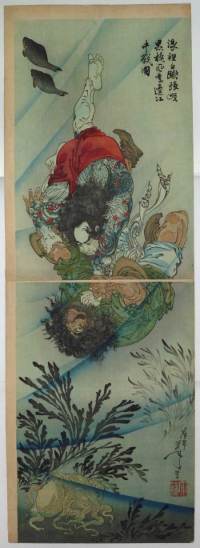Cho Jun and Ri Ki wrestling underwater
In the new offerings is a vertical Yoshitoshi diptych of Cho Jun and Ri Ki wrestling underwater. This is the earliest known state of what is considered one of Yoshitoshi’s best designs – before the first publisher’s name (Matsui Eikichi) and date (20,2,1887) in lower left margin was printed. This gives an opportunity to examine the differences in printing between the earliest and last editions. (The diptych was subsequently reprinted by Hasegawa Tsunejiro in 1,9,1887.)
From the late 18th century there was a history of publishing some prints in a deluxe edition and a more affordable version of the same design: Paper, pigments and nuances in printing could all be adjusted. And by the time we come to some of Hiroshige’s better known sets we find the first editions had great care lavished on them with extra bokashi (grading the pigment by hand), better pigments and paper. The Hundred Views of Edo is a prime example of this: Every care was taken to convey the atmosphere of a scene. Later editions lack these subtleties with commercial considerations taking precedent. This is certainly true of many of Yoshitoshi’s sets as well.

The impression offered here shows all the attributes of the earliest printing: Extremely beautiful and careful wiping of the blue block to render the currents of water; careful modulation of the gradation on the fish at top and also on the sea-weed at the bottom. The later printings – even the first with Matsui Eikichi – lack finesse in the printing of the water and in the republished version there is often no attempt to gradate the foreground sea-weed. The pigments are also of a finer quality on this early state , a better red being used on Cho Jun’s trousers. It was the job of the printers to breathe life, so to speak, into the image, to give form and depth by means of skilled bokashi; to augment a design by wiping on clouds or spraying pigment to imitate dust or snow. This all took time rather than relying on a key-block outline and blocks of colour.The only other difference, of course, between early and late printings is the quality of the impression. The more prints that were pulled, the more the blocks wore down producing weak outlines.